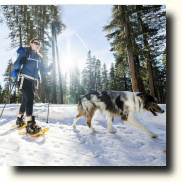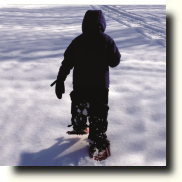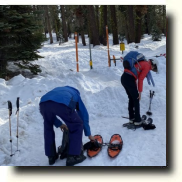Snow Shoe Adventures


What started as a necessary means of travel thousands of years ago has evolved into a popular alternative winter activity for recreation and fitness. Why? Well, it’s fun. That’s why.
How do you get started? It’s easy. As the saying goes, “If you can walk, you can snowshoe.”
It’s also inexpensive. You only need snowshoes, hiking boots, warm clothing, gloves, head gear and perhaps poles. That’s it!
The learning curve is also much shorter than skiing, snowboarding or cross country treks. All it takes is a few techniques to practice. These include widening your stance (so you don’t trip on your snowshoes), going up and down hills, traversing slopes and pole usage.
Snowshoeing offers participants a low-impact, aerobic exercise that helps you stay in shape during the winter. It’s versatile. You can get an easy workout or be aggressive. Plus, your dog can follow along.
Trail etiquette is important. You will often be sharing the trail with cross-country skiers. Try to make your own trail whenever possible, staying out of the tracks these skiers have worked so hard to set. Skiers have the right-of-way on trail systems. This is obvious, since it’s easier for you to step off the trail safely than it is for a cross country skier to stop or go around. Always be polite to the folks you meet along the trail.
Snowshoeing techniques are simple. Get going by walking on flat surfaces when you first start out. Most snowshoes have simple “strap and go” bindings that fit a wide range of boot styles and sizes. Your stance should be wider than normal when you’re on snowshoes in order to keep you from stepping on the insides of your frames.
Consequently, you may feel your hips and groin muscles ache after the first few times out. If possible, walk in the steps made by the person in front of you.
Always pay attention to your physical condition, the environment and your gear. Stick to established trails at first. The local SnoPark areas have cross-country ski trails that those snowshoeing can share. That way, you’re never too far from others, and you’re not likely to encounter avalanche hazards. Do not snowshoe alone.
Be aware of winter hazards like creek crossings, changes in weather along with tree or rock wells. If you plan to venture away from a patrolled ski area, be sure you and your companions are prepared. Carry a topographic map of the area, a compass and possibly an altimeter or a GPS to help you navigate. Know how to use them. The winter backcountry is not the best place to learn. Before heading out, leave your trip plans with a responsible person and let them know whom to contact in case you don’t return on time.
Know the signs of hypothermia so you can recognize them in members of your party. Stay hydrated by drinking water to keep your muscles functioning and helping your body fend off hypothermia. Keep your water from freezing by using an insulating cover for your water bottle. A vacuum bottle with hot drinks will keep you hydrated and warm.
REI at Riverpark and Shaver Lake Sports will rent and sell snowshoes. They will fit you with a pair that is appropriate for you You don’t need special shoes for snowshoeing, just waterproof hiking boots.
It’s easy to learn to use snowshoes. Within five minutes you’ll be having a good time. You’re not going to be able to go as far as you can walk. So if you are used to walking five miles on a hike during the summer, you are probably going to go about two and a half miles in that same amount of time.
For snowshoes, it’s imperative that you have the right size and maybe even have extensions for them so you don’t sink into the snow. Extensions are tails that you clip onto the end of snowshoes to increase the surface area meaning you won’t sink.
The size of snowshoes are dependent on how much a person weighs. The heavier a person is the larger snowshoes they’ll need to keep them from sinking into the snow.
The sales staff at the store from which you bought or rented them will make sure you have the right ones for your height and weight.



